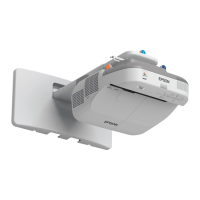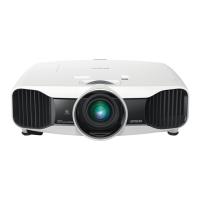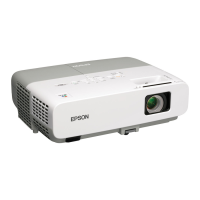Quick Setup
Before using the projector, make sure you read the safety instructions in the
online User’s Guide.
Connect the projector
Choose from the following connections. See the sections below or the online
User’s Guide for details.
Computer
USB cable
HDMI cable
VGA cable
Stereo mini cable
USB port
Connect the square end of a USB cable to the projector’s USB-B (square) port.
Connect the flat end of the cable to any USB port on your computer.
Windows
®
XP or later: After turning on the projector, follow the on-screen
instructions to install the Epson
®
USB Display software (EMP_UDSE.EXE; only
on first connection). If the software screen does not display automatically,
open My Computer or Computer, then double-click EPSON_PJ_UD.
OS X 10.5.8 or higher: After turning on the projector, the setup folder for
USB Display appears in the Finder. Double-click USB Display Installer and
follow the on-screen instructions to install the Epson USB Display software
(only on first connection).
Computer port
Connect one end of a VGA cable to the projector’s Computer1 or
Computer2 ports, and the other end to your computer’s
monitor port.
If you are using a laptop, switch it to external display (see “Troubleshooting”).
You can also connect an audio cable.
HDMI port
Connect one end of an HDMI cable to the projector’s HDMI port and the other
end to an HDMI port on your computer.
Wired network
You can connect the projector to your network using an Ethernet cable. See
“Project over a wired network” for instructions.
Video device
Connect multiple video devices and use the Source Search button on the
projector or remote control to switch between them.
Component video to VGA cable
HDMI cable
RCA video cable (composite video)
S-Video cable
RCA Audio cable
Camera, USB device, or Epson DC-06 document camera
Connect a digital camera, USB flash drive, USB storage device, or Epson DC-06
document camera to the projector’s USB-A (flat) port.
If you connect a digital camera, USB flash drive, or USB storage device, you can
use the projector’s PC Free feature. You can also connect other Epson document
cameras to the projector. See the online User’s Guide for details.
Turn on your equipment
1
Turn on your computer or video source.
2
Plug in the projector. The power light on the projector turns blue.
3
Press the power button on the projector or remote control. The
projector beeps, and the Status light flashes blue and then stays on.
Note: To shut down the projector, press the power button twice, then
unplug it. You don’t have to wait for the projector to cool down.
4
The default language of the menu system is English. To select another
language, press the Menu button on the projector or remote control.
Select Extended and press . Select Language and press .
Select your language and press . Press the Menu button to exit
the menu system.
Adjust the image
1
If you don’t see an image, press the Source Search button on the
projector or the remote control to select the image source.
Note: If you still see a blank screen or have other display problems, see
the troubleshooting tips on the back of this sheet.
2
To raise the image, press the foot release button and lift the front of the
projector. Release the button to lock the foot in position.
3
Press the Wide or Tele buttons on the projector to reduce or enlarge the
image.
4
Turn the focus ring to sharpen the image.
5
If your image looks like or , you may have placed the projector
off to one side of the screen at an angle. Place the projector directly in
front of the center of the screen, facing the screen squarely. If you
can’t move the projector, press the or button on the projector to
open the keystone correction menu then use the Wide or Tele buttons to
correct the image.
6
If your image looks like or , you can press the or
button on the projector to correct it.
Using the remote control
Make sure the batteries are installed as shown (two AA batteries).
Choose which
source to display
Turn projector
on and off
Access projector
menus
Turn off projector
display
Get solutions to
common problems
Navigate projector
menus
Switch between computer and
interactive pen
For more information on using the remote control, see the online User’s
Guide.
Project wirelessly from a
computer
Follow the steps here to connect the projector over a wireless network. You
will need the optional wireless LAN module (part number V12H418P12).
1
To install the optional wireless LAN module, first remove the screw as
shown.
2
Connect the wireless LAN module to the USB-A (flat) port.
3
To configure your projector for wireless projection, do one of the
following:
•
If you’re using the optional Quick Wireless Connection USB key
(Windows only, part number V12H005M09), press the LAN button on
the remote control. When you see SSID and IP address information
on the screen, remove the wireless LAN module and connect the
key to the projector’s USB-A port. Look for the displayed message,
remove the key, and connect it to a USB port on your computer.
Follow your computer’s on-screen instructions to install the driver,
then reconnect the wireless LAN module to the projector’s USB-A
port. For details, see the online User’s Guide.
•
If you’re not using the key, continue with step 4.
PowerLite
®
520/525W/530/535W
4127945 Rev.0
1-F C
4127945 Rev.0
1-F M
4127945 Rev.0
1-F Y
4127945 Rev.0
1-F K













